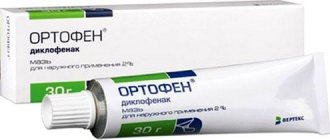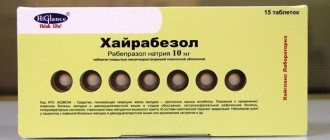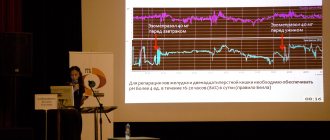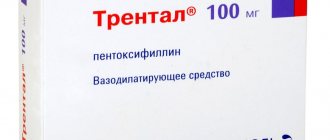Compound
| Each tablet contains the active substance: | |
| Erythromycin (in terms of active substance) 250 mg | |
| Tween-80 (polysorbate) | 5.8 mg |
| Calcium stearate | 4.8 mg |
| Polyvinylpyrrolidone (povidone) | 29.6 mg |
| Croscarmellose sodium | 9.0 mg |
| Potato starch | To obtain an uncoated tablet weighing 450.0 mg |
| Shell excipients: | |
| Titanium dioxide | 0.5 mg |
| 1,2-propylene glycol | 2.3 mg |
| Collicut MAE 100R | 15.1 mg |
| Talc | 4.1 mg |
Description:
Round biconvex tablets, film-coated, white or white with a grayish tint; On a cross section, the core is white or almost white.
Pharmacotherapeutic group: antibiotic - macrolide.
ATX code:
J01FA01
Pharmachologic effect:
Pharmacodynamics
A bacteriostatic antibiotic from the macrolide group, reversibly binds to the 50S subunit of bacterial ribosomes, blocks protein synthesis, prevents the growth and reproduction of bacteria (does not affect the synthesis of nucleic acids). In high doses it can have a bactericidal effect. The spectrum of activity includes gram-positive (Staphylococcus spp., producing and non-producing penicillinase, including Staphylococcus aureus; Streptococcus spp. (including Streptococcus pneumoniae, Streptococcus pyogenes), alpha-hemolytic streptococcus (Viridans group), Bacillus anthracis, Corynebacterium diphtheriae, Corynebacterium minutissimum) and gram-negative microorganisms (Neisseria gonorrhoeae, Haemophilus influenzae, Bordetella pertussis, Brucella spp., Legionella spp., including Legionella pneumophila) and other microorganisms: Mycoplasma spp. (including Mycoplasma pneumoniae), Chlamydia spp. (including Chlamydia trachomatis), Treponema spp., Rickettsia spp., protozoa: Entamoeba histolytica, Listeria monocytogenes.
Gram-negatives are resistant to erythromycin: Escherichia coli, Pseudomonas aeruginosa, as well as Shigella spp., Salmonella spp. and others. The sensitive group includes microorganisms whose growth is delayed at an antibiotic concentration of less than 0.5 mg/l, moderately sensitive - 1-6 mg/l, moderately resistant and resistant - 6-8 mg/l.
Pharmacokinetics
Absorption is high. Eating does not affect the absorption of erythromycin enteric-coated tablets. The maximum concentration (Cmax) is reached after 2-4 hours. Communication with plasma proteins is 70-90%.
Bioavailability - 30-65%. It is distributed unevenly in the body. It accumulates in large quantities in the liver, spleen, and kidneys. In bile and urine, the concentration is tens of times higher than the concentration in plasma. Penetrates well into the tissues of the lungs, lymph nodes, middle ear, prostate secretions, sperm, pleural cavity, ascitic and synovial fluid. In the milk of lactating women, the concentration of erythromycin is 50% of the serum concentration. Penetrates poorly through the blood-brain barrier. During inflammatory processes in the meninges, their permeability to erythromycin increases slightly. Penetrates through the placental barrier.
Metabolizes in the liver (more than 90%), partially with the formation of inactive metabolites. The half-life (T1/2) is 1.4-2 hours, with anuria - 4-6 hours. Excretion with bile - 20-30% unchanged, by the kidneys (unchanged) - 2-5%.
Description and operation of the medicine
Erythromycin belongs to the group of antibiotics, is a macrolide (azalide), and is sold in pharmacies with a prescription. The drug costs about 60 rubles for 10 tablets with a dosage of 250 mg of erythromycin, the main active substance. Erythromycin is produced by different pharmaceutical companies, Irbitsky Chempharm and others. produces Erythromycin-Lect.
Erythromycin ointment is available for sale at a price of 115 rubles.
The tablets are enteric-coated, they are white or beige, round, convex. Additional substances in the composition include povidone, starch, calcium stearate, polysorbate, the shell consists of silicone, macrogol and a number of other components. The drug has a powerful bacteriostatic effect and is bactericidal in large doses. Erythromycin binds to ribosomal units, blocking the production of peptides by microbes. Many bacteria are sensitive to it:
- staphylococci (regardless of the ability to produce penicillinase);
- streptococci of the viridans, pneumonia, pyogenes groups;
- bacteria of the genus Bacillus;
- corynebacteria;
- listeria;
- campylobacter;
- legionella;
- bordetella;
- hemophilus influenzae;
- neisseria.
The drug has a negative effect on the vital activity of mycoplasma, chlamydia, ureaplasma, as well as other pathogens of sexually transmitted infections (for example, treponema).
Escherichia coli, Proteus, Klebsiella and Shigella show resistance to it. Many anaerobes also do not stop developing when taking Erythromycin, therefore, before prescribing therapy, it is important to carry out bacteriological studies.
Indications for use
Infectious and inflammatory diseases caused by sensitive microflora: diphtheria (including bacterial carriage), whooping cough (including prevention), trachoma, brucellosis, Legionnaires' disease, erythrasma, listeriosis, scarlet fever, amoebic dysentery, gonorrhea; genitourinary infections in pregnant women caused by Chlamydia trachomatis; uncomplicated chlamydia in adults (with localization in the lower genitourinary tract and rectum), with intolerance or ineffectiveness of tetracyclines, etc.; infections of the ENT organs (tonsillitis, otitis media, sinusitis); biliary tract infections (cholecystitis); infections of the upper and lower respiratory tract (tracheitis, bronchitis, pneumonia); infections of the skin and soft tissues (adolescent acne, infected wounds, bedsores, stage II burns, trophic ulcers), infections of the conjunctiva.
Infections caused by streptococci (tonsillitis, pharyngitis).
Prevention of infectious complications during medical and diagnostic procedures (including dental interventions, endoscopy, in patients with heart defects).
Treatment of infectious and inflammatory diseases caused by pathogens (in particular Staphylococcus spp.) resistant to penicillin, tetracycline, chloramphenicol, streptomycin
Indications of the medicine
The medicine can be taken by children and adults for various localizations of infectious diseases, if they were caused by microorganisms sensitive to erythromycin. For infections of the respiratory tract, ENT organs, and throat, the drug is used in the following cases:
- sore throat (tonsillitis);
- otitis;
- sinusitis;
- whooping cough;
- prevention of whooping cough in contact with a patient;
- pneumonia;
- tracheitis;
- bronchitis.
Externally and when taken orally, the remedy is prescribed for acne, boils, extensive pustular diseases, and against juvenile acne. It can also be used for infected wounds, ulcers, burns, and infected bedsores. In ophthalmology, the drug is used for any infections of the eyelids, mucous membranes, and eye structures.
The medicine is indicated for use in cases of diphtheria and the carriage of the bacteria that causes it (Corynebacterium).
Other indications include trachoma and brucellosis, Legionnaires' disease - legionellosis. In children, Erythromycin is often used for scarlet fever, in adults - for gonorrhea and listeriosis.
It is also used in the acute phase of cholecystitis to relieve inflammation of the gallbladder, as well as in patients with rheumatism to prevent complications in the heart, kidneys, and joints after an infection. The drug can be taken even by pregnant women, mainly for the treatment of chlamydia that threatens the fetus.
WE RECOMMEND THE ARTICLE!
Sumamed is an integral part of the treatment of many acute respiratory lesions. Read more >>
Directions for use and dosage:
Inside.
A single dose for adults and adolescents over 14 years of age is 250-500 mg, daily - 1-2 g. The interval between administration is 6 hours. For severe infections, the daily dose can be increased to 4 g.
For the treatment of diphtheria carriage - 250 mg 2 times a day.
For amoebic dysentery in adults - 250 mg 4 times a day, course duration - 10-14 days.
For legionellosis - 500-1000 mg 4 times a day for 14 days.
For gonorrhea - 500 mg every 6 hours for 3 days, then 250 mg every 6 hours for 7 days.
For tonsillitis, pharyngitis, adults - 20-50 mg/kg/day, children - 20-30 mg/kg/day, course duration - at least 10 days.
For the prevention of septic endocarditis in patients with heart defects - 1 g for adults 1 hour before a treatment or diagnostic procedure, then 0.5 g for adults again after 6 hours.
For whooping cough - 40-50 mg/kg/day for 5-14 days.
For genitourinary infections during pregnancy - 500 mg 4 times a day for 7 days or (if tolerated) - 250 mg 4 times a day for 14 days.
In adults, with uncomplicated chlamydia and intolerance to tetracyclines - 500 mg 4 times a day for at least 7 days.
Instructions for Erythromycin
How much and how to take Erythromycin depends on the stage, form, severity of the disease and the age of the patient. The localization of the infectious process is also important. The average doses/day are:
- children under 3 months - 20-40 mg/kg;
- 4 months - 14 years - 30-50 mg/kg;
- adults - 1-4 years.
These doses should be divided into 4 doses/day. Take the tablets orally, 2 hours after meals, or an hour before meals. The course lasts until the symptoms of the disease end, plus another 2 days, or 5-14 days according to the doctor’s decision. In case of overdose, the development of liver dysfunction up to an acute form and temporary hearing loss are possible. For treatment, the patient is urgently given sorbents and, depending on the severity of the condition, is left under medical supervision for 1-10 days. The patient may need to maintain pulmonary and cardiac function.
Side effect
From the digestive system: nausea, vomiting, gastralgia, abdominal pain, tenesmus, diarrhea, dysbacteriosis, rarely - oral candidiasis, pseudomembranous enterocolitis, liver dysfunction, cholestatic jaundice, increased activity of “liver” transaminases, pancreatitis.
On the part of the hearing organs: ototoxicity - hearing loss and/or tinnitus (when used in high doses - more than 4 g / day, usually reversible).
From the cardiovascular system: prolongation of the QT interval on the ECG, atrial fibrillation and/or flutter (in patients with a prolonged QT interval on the ECG).
Allergic reactions: urticaria, other forms of skin rash, eosinophilia, rarely - anaphylactic shock.
Contraindications, negative actions
The medicine is approved for children from birth, although some manufacturers indicate the possibility of using this dosage form (coated tablets) only from 14 years of age. In any case, therapy in childhood is carried out under medical supervision. The medicine has the following contraindications:
- allergies, intolerances;
- severe hearing loss;
- lactation.
Treat with caution in case of arrhythmias, hepatitis or jaundice of a different nature in the past, pregnancy, renal, hepatic dysfunction. In pregnant women, Erythromycin is used only under strict indications!
Possible side effects include allergies - rash, skin itching, redness, Quincke's edema (rare), eosinophilia in the blood.
Compared to penicillins, reactions from the gastrointestinal tract are rare. People exposed to them may experience nausea, diarrhea, abdominal pain, colitis, and occasionally jaundice; it is also possible to develop dysbacteriosis and oral candidiasis. Other side effects may include changes in heart rhythms, tinnitus, and in severe cases, hearing loss.
Interaction with other drugs
Reduces the bactericidal effect of beta-lactam antibiotics (penicillins, cephalosporins, carbapenems).
Increases the nephrotoxicity of cyclosporine (especially in patients with concomitant renal failure).
Reduces the clearance of triazolam and midazolam, and therefore may enhance the pharmacological effects of benzodiazepines.
Slows down the elimination (increases the effect) of methylprednisolone, felodipine and coumarin anticoagulants.
Increases the bioavailability of digoxin.
Reduces the effectiveness of hormonal contraception.
Drugs that block tubular secretion prolong the half-life of erythromycin.
When taken simultaneously with drugs that are metabolized in the liver (theophylline, carbamazepine, valproic acid, hexobarbital, phenytoin, alfentanil, disopyramide, lovastatin, bromocriptine), the concentration of these drugs in plasma may increase (it is an inhibitor of microsomal liver enzymes).
When taken simultaneously with terfenadine or astemizole - the possibility of developing arrhythmia, with dihydroergotamine or non-hydrogenated ergot alkaloids - vasoconstriction to spasm, dysesthesia.
Incompatible with chloramphenicol (antagonism).
When co-administered with lovastatin, rhabdomyolysis increases.
special instructions
Due to the possibility of passage into breast milk, breastfeeding should be discontinued when erythromycin is prescribed.
During long-term therapy, it is necessary to monitor laboratory parameters of liver function.
Symptoms of cholestatic jaundice may develop several days after the start of therapy, but the risk of development increases after 7-14 days of continuous therapy.
The likelihood of developing an ototoxic effect is higher in patients with renal and liver failure, as well as in elderly patients.
Some resistant strains of Haemophilus influenzae are sensitive to simultaneous administration of erythromycin and sulfonamides.
May interfere with the determination of catecholamines in urine and the activity of “liver” transaminases in the blood (colorimetric determination using definylhydrazine).








